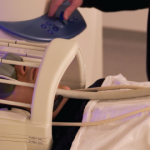For Professor Jones, this means an approach to pain management that harnesses the brain to correct itself. “The brain is a powerful organ and can be trained to take more control over the experience of pain,” he says. In a recently published study, he and his colleagues showed the ability of mindfulness-based talking therapies to substantially reverse some of the “fine-tuning” problems of a brain trying to integrate both the sensory and emotional pathways turned on by pain.4 The study showed that patients, through mindfulness-based talking therapies, can learn to take more control over their pain experience, according to Professor Jones.
Along with talking therapies, he emphasized the important role of exercise in managing chronic pain. “Long-term exercise and talking therapies have the best ratio of benefit to harm,” he says. “So these are worth investing in in the long term.”
Going Forward

Dr. Davis
As studies continue to try to identify specific biomarkers of chronic pain, discussion of the best ways to apply this research is fully underway. In September 2017, a presidential task force of the International Association for the Study of Pain published a consensus statement recommending against the use of brain imaging as a test for chronic pain.5 Led by Karen Davis, PhD, head of the division of Brain, Imaging and Behaviour-Systems Neuroscience at the Krembil Research Institute in Toronto Western Hospital in Toronto, Ontario, Canada, the consensus statement discusses the medical, legal, and ethical issues involved with using brain imaging tests for chronic pain.
Dr. Davis says that although the task force believes brain imaging can serve an important role in discovering the brain mechanisms underlying pain, and possibility help predict therapies that help individual patients, she cautioned that some negative unintended applications of such imaging could disadvantage the patient. “A key concern of using biomarkers of pain regards diagnostics of chronic pain, whether an individual patient does or doesn’t experience pain,” she says, adding that such diagnostics “then could be used to deny or restrict medical care or coverage of costs.”
Professor Jones agrees that until a clearer understanding of the neurobiology of pain emerges and biomarkers are identified, the question of how to use them in clinical practice remains a question. Functional brain imaging “has no place in the routine management at the moment,” he says.
Mary Beth Nierengarten is a freelance medical journalist based in Minneapolis.
References
- Brown CA, El-Deredy W, Jones AK. When the brain expects pain: Common neural responses to pain anticipation are related to clinical pain and distress in fibromyalgia and osteoarthritis. Eur J Neurosci. 2014 Feb;39(4):663–672.
- Morton DL, Sandhu JS, Jones AK. Brain imaging of pain: State of the art. J Pain Res. 2016 Sep 8;9:613–624.
- Kutch JJ, Ichesco E, Hampson JP, et al. Brain signature and functional impact of centralized pain: A multidisciplinary approach to the study of chronic pelvic pain (MAAP) network study. Pain. 2017 Oct;158(10):1979–1991.
- Jones AKP, Brown CA. Predictive mechanisms linking brain opioids to chronic pain vulnerability and resilience. Br J Pharmacol. 2017 Apr 27.
- Davis KD, Flor H, Greely HT, et al. Brain imaging tests for chronic pain: Medical, legal and ethical issues and recommendations. Nat Rev Neurol. 2017 Oct;13(10):624–638.
